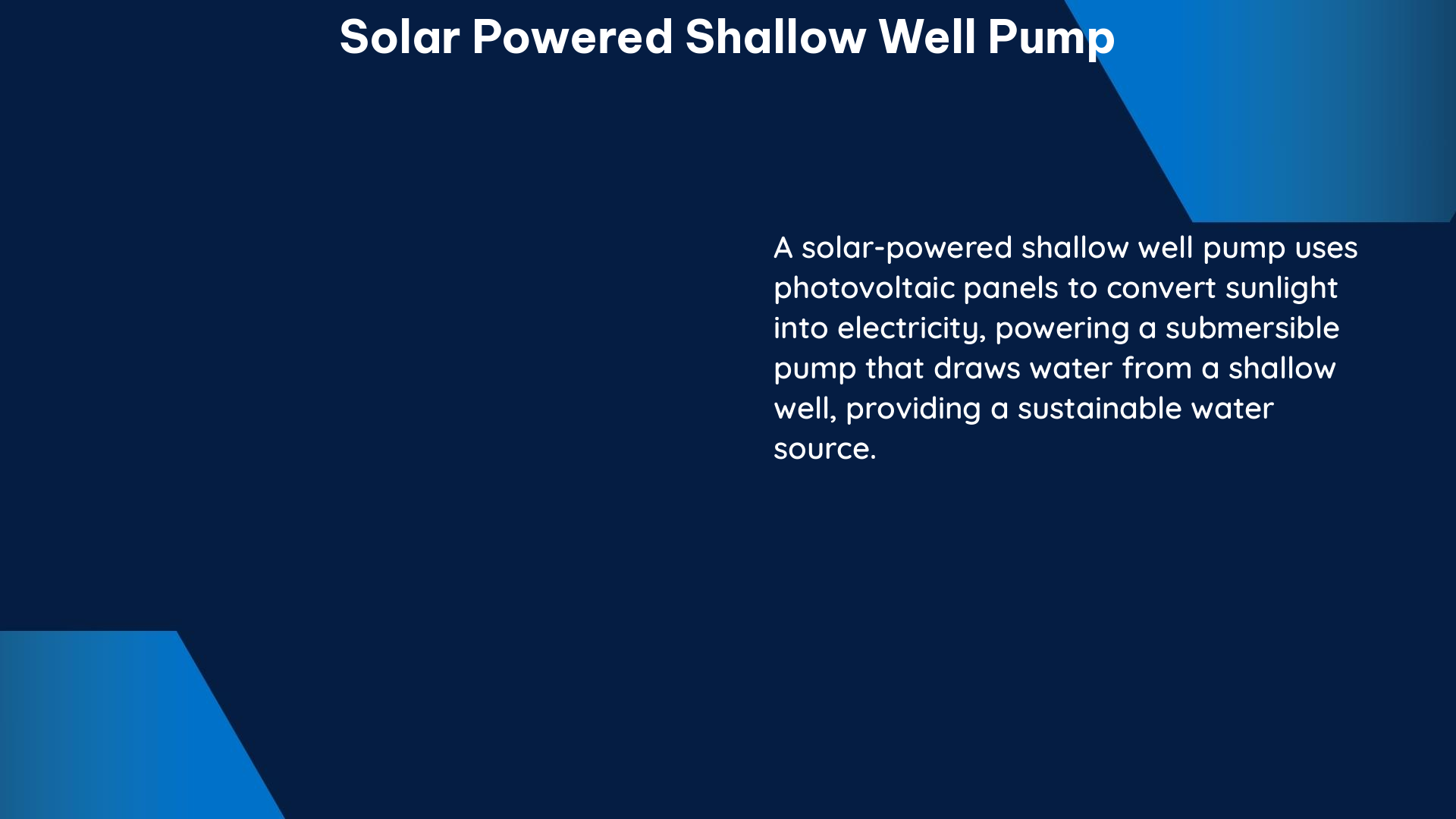Solar-powered shallow well pumps offer a sustainable and cost-effective solution for water pumping, especially in remote or off-grid locations. These systems harness the power of the sun to extract water from shallow wells, providing a reliable source of water for various applications, such as irrigation, livestock watering, and domestic use.
Understanding the Basics of Solar-Powered Shallow Well Pumps
Solar-powered shallow well pumps typically consist of a submersible pump, a solar panel array, and a controller or inverter. The pump is installed in the well, while the solar panels are positioned to capture the maximum amount of sunlight. The controller or inverter manages the flow of electricity from the solar panels to the pump, ensuring efficient and reliable operation.
The size and capacity of the solar system required to power a shallow well pump depend on several factors, including:
- Pump Specifications: The pump’s flow rate, head (pressure), and power consumption are crucial in determining the appropriate solar system size.
- Water Usage: The daily or weekly water demand for the intended application, such as irrigation or livestock watering, will influence the pump’s size and the solar system’s capacity.
- Solar Insolation: The amount of solar radiation available at the installation site, which varies based on location, time of year, and weather conditions, affects the solar system’s performance.
- System Efficiency: Factors such as cable losses, inverter efficiency, and other system components’ performance can impact the overall efficiency of the solar-powered pump system.
Calculating the Solar System Size

To estimate the required solar panel size for a shallow well pump, you can follow these steps:
- Determine the Pump’s Power Consumption: Convert the pump’s power consumption from watts to kilowatt-hours (kWh) per day, assuming the pump operates 24/7.
- Calculate the Solar Panel Size: Divide the daily energy consumption (in kWh) by the average daily solar insolation (in kWh/m²/day) and the system efficiency (typically around 80%) to determine the required solar panel size in kilowatts (kW).
- Select the Solar Panels: Choose solar panels with the appropriate wattage and voltage to match the pump’s power requirements and the system’s design.
- Incorporate Backup Storage: Consider adding a battery bank or other energy storage system to provide power during periods of low solar radiation or when the pump is not in use.
Optimizing System Performance
To ensure optimal performance and reliability of your solar-powered shallow well pump system, consider the following:
- Pump Priming: Properly priming the pump before initial operation is crucial to prevent damage and ensure efficient water extraction.
- Pump Curve Characterization: Measure the pump’s performance characteristics, such as flow rate and pressure, under different operating conditions to ensure it meets the system’s requirements.
- Remote Monitoring: Utilize data-logging and remote-sensing technologies to monitor the system’s output, usage, and overall performance, allowing for timely maintenance and adjustments.
- Seasonal Adjustments: Adapt the solar panel orientation or tilt angle to maximize energy production during the seasons with the lowest solar insolation, ensuring consistent water supply throughout the year.
- Maintenance and Cleaning: Regular maintenance, such as cleaning the solar panels and checking for any system issues, can help maintain the system’s efficiency and longevity.
Practical Applications and Case Studies
Solar-powered shallow well pumps have been successfully deployed in various applications, including:
- Irrigation: Providing a reliable water source for small-scale or remote agricultural operations, reducing the reliance on grid-connected or diesel-powered pumps.
- Livestock Watering: Supplying water for livestock in remote pastures or areas without access to the electrical grid.
- Domestic Water Supply: Delivering a sustainable water supply for households in off-grid or underserved communities.
A study conducted by researchers on solar-powered water pumps for irrigation revealed valuable insights into the technical performance of these systems. The researchers used specialized remote-sensing prototypes to characterize the output and usage of solar-powered water pumps in the field, providing valuable data on system efficiency and reliability.
Conclusion
Solar-powered shallow well pumps offer a sustainable and cost-effective solution for water pumping, particularly in remote or off-grid locations. By understanding the key factors that influence the system design, such as pump specifications, water usage, and solar insolation, you can optimize the performance and reliability of your solar-powered shallow well pump system. With proper installation, maintenance, and monitoring, these systems can provide a reliable and environmentally-friendly water supply for a wide range of applications.
References:
- DIY Solar Forum – Calculate Solar Size for My Deep Well Pump and Other Appliances
- Oxfam – Solar Pumping for Water Supply
- USAID – Solar-Powered Irrigation Systems: A Clean-Energy Solution for Farmers in Developing Countries
- USDA NRCS – Solar-Powered Water Pump Systems for Stockwater Design

The lambdageeks.com Core SME Team is a group of experienced subject matter experts from diverse scientific and technical fields including Physics, Chemistry, Technology,Electronics & Electrical Engineering, Automotive, Mechanical Engineering. Our team collaborates to create high-quality, well-researched articles on a wide range of science and technology topics for the lambdageeks.com website.
All Our Senior SME are having more than 7 Years of experience in the respective fields . They are either Working Industry Professionals or assocaited With different Universities. Refer Our Authors Page to get to know About our Core SMEs.